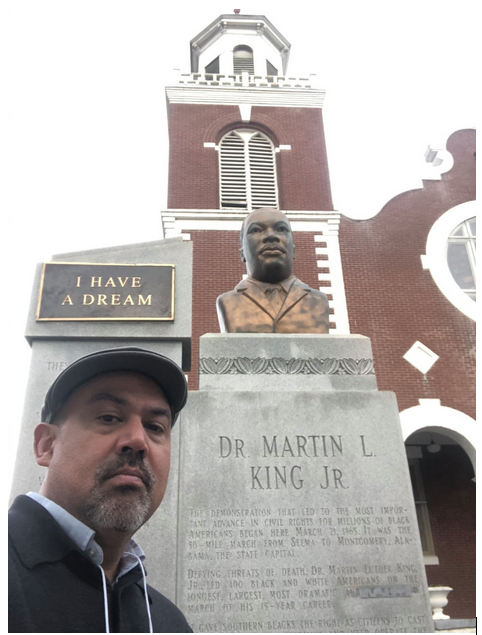
Roberto Vargas
Associate Director, Center for Community Engagement & Senior Staff, Clinical and Translational Science Institute, UCSF
Dismantling anti-Blackness in a full embrace of ourselves
Last year, I decided I wanted to do a deeper dive into the history of the African Diaspora in Latin America, and some histories of African American solidarity with La Raza peoples in the United States.
I wanted to do this not only for my own learning but also to share with my colleagues at UCSF during Black History Month.
The Equal Justice Initiative’s Museum in Montgomery, Alabama reminded me of the extensive African presence in Latin America through their animated maps of the Trans-Atlantic Human Trafficking of African people into the Americas.
Those animated maps help demonstrate a fact that stunned me when I first learned it: approximately 80% or more of the people trafficked out of Africa in bondage were brought to the Americas between the Carribean and South America, and only about 6-10% of those people ended up in British North America, or what would ultimately become the United States.
I was aware of these histories through my Ethnic Studies education at San Francisco State University in the 90’s, but that was several decades ago. I needed a refresher, and I wanted to share these histories with my colleagues, so many of whom have not had the great blessing of an Ethnic Studies education—inspired by the education offered us by the Equal Justice Initiative.
I want people to understand that as “Raza Latina,” — roughly translated as a “Latin Race” — we are a diverse group with multiple ethnic and racial backgrounds. These labels used to identify us, such as Latinx, Hispanic, and Latiné, focus on our European ancestry, but ignore our Native and African roots, just like many of our own family histories do.
This is rooted in White Supremacy. Racism. Both at the societal level and at the level of families and individuals who proudly lift up our European ancestry but ignore or deny our ancestors native to the Americas or Africa.
I created a slideshow to introduce people to the history of how nearly six times the number of African captives were brought to the Caribbean and Central and South America, as compared to North America.
I recounted the stories of various Quilombos, which were often small nations or fortified settlements comprised mainly of Africans seeking freedom from slavery, alongside indigenous and non-conforming Portuguese or Spanish individuals who rejected the racial hierarchy imposed by Portuguese and Spanish colonizers in colonial, mostly port-based settlements.
I shared that one major difference between British colonies and colonies of the Spanish was that the Spanish allowed for inter-marriage. While both systems of White Supremacy relied on the establishment of a Caste system that determined power relations based on phenotype—how we look—the Spanish version required an elaborate hierarchy based on the many mixtures of Native, African, and European lineage.
In my research, I found several versions of this social pyramid, but every version placed people with lighter skin at the top and those with more African features at the bottom. This is the genesis of anti-Blackness in the Americas. It was the genesis of racist ideology in the Americas, even preceding that first ship to land in the British colonies in 1619.
Sharing these histories help people understand that the people known as Latinos are also often descendants of Africans—like I am—though that history is unknown to current generations my family, and only revealed in our curly hair and now a DNA analysis.
I want people to know that anti-Blackness was imposed as part of our collective process of colonization, and I want people to know this at the same time I extend an invitation to us all to decolonize. Ourselves, our histories, and our institutions. Our minds.
We must re-Indigenize and re-Africanize ourselves. We must embrace all of who we are, as part of our collective healing. And as an invitation for us to understand that White Supremacy was imposed on us long ago. With a consciousness of these facts and this history, we are invited to abandon anti-Blackness not merely in solidarity with Black people, but as an embrace of our full selves.
I also shared the history of La Raza solidarity between the Brown Berets and the Black Panthers in the SF Bay Area during the San Francisco Strikes of 1969 that helped produce the only School of Ethnic Studies in the world. They joined forces to feed children, support families, and combat police brutality within our communities, and I am proud to say that my family was part of that important work.
The Young Lords Party in Chicago and the Bronx stood in solidarity with the Black Panther Party, fighting for equity in garbage collection, access to vaccinations, and Patients’ Rights at Lincoln Hospital in the Bronx. The important community-based, grassroots efforts were some of the earliest efforts and successes of environmental justice, access to care and patients’ rights activism.
I shared stories of our work across Black, Brown, and Asian and Pacific Islander communities in San Francisco—in partnership with UCSF—to reduce chronic disease inequity. The stories I shared help to dismantle the narrative that our communities are in competition, or in conflict.
All these stories I shared as part of a collective effort to dismantle anti-Blackness, and to see examples throughout hundreds of years of our collective alignment for liberation.
In the future, I would like to lift up the many stories of white people who risked or lost their lives in the struggle for liberation of Black and indigenous people. Those too, are histories that must be told and known, so that white people are not left with the misconception that they only descend from oppressors, or that they must only either identify with oppressors or be ashamed of their ancestors.
I want white people to identify with brave freedom fighters like John Brown. Or non-violent abolitionists who risked everything to support the Underground Railroad. I hope that through these histories, we will be inspired to do more for racial and social justice. It is my wish that we will feel compelled to do more for our collective liberation from racism and other forms of oppression.
And in this way, I hope to help foster the learning and coalition-building that I believe to be two important elements of what we gain by way of this beautiful and imperfect experience we know as the Alabama Pilgrimage, #PursuingProgress.
